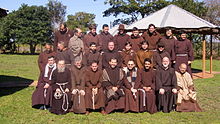Order of Capuchin Friars Minor
Order of Friars Minor Capuchin (Ordo Fratum Minorum Cappuccinórum, abbreviated O.F.M. Cap.), better known as the lesser friars cappuccinos. They are a reform of the Ordo Fratrum Minorum (OFM).
History
It was started in 1525, by Mateo de Bascio and by the brothers Ludovico di Fossombrone and Rafaele di Fossombrone, in the company of other Franciscans.
Its initiators were observant who went to retirement convents, to have a more contemplative life there. Over time their number grew and they decided to reform the Franciscan order. This was very common at that time, since there are many Franciscan reforms that are located within the observance. They separated from the observers and were under the obedience of the General Minister of the Conventuals until they had their own General Minister.
Like the other branches, the Capuchins generally dedicate themselves to the pastoral care of parishes. However, they appreciate the contemplative life and study.
The Capuchins consider themselves the heir branch of the spirituals of early Franciscanism, despite having been founded several centuries later. They wear a habit inspired by the habit of Saint Francis preserved in Assisi, with a rope (like the Observant Franciscans and other Franciscan reforms), but the main difference between the members of the family instituted by Francis of Assisi is that they wear a hood attached to the tunic (according to the shape of the original habit worn by Saint Francis) and is longer compared to the other branches. An exhaustive analysis of the importance of the shape of the Franciscan habit and the use of long and unkempt beards, has been carried out by the historian Anel Hernández Sotelo, in her work «A history of beards and hoods. The deconstruction of the figure of Saint Francis. XVII -XVIII centuries» published by the Colombian Institute of Anthropology and History in 2017.
Relevant characters of the order
- François Leclerc du Tremblay, known as Father Joseph (1577 - Rueil, December 18, 1638), was a French Capuchin friar, advisor to Cardinal Richelieu and for whom the term "gray eminence" was coined.
- Ambrosio de Valencina (Valencina de la Concepción, Seville, November 5, 1859 - Seville, May 24, 1914), was a Spanish friar and writer.
- San Lorenzo de Brindis, priest and doctor of the Church
- San Felix de Cantalicio, the son of two pious peasants, in his youth he dedicated himself to shepherding sheep, before entering the Order.
- Saint Fidel of Sigmaringen, an apostle of Switzerland, Austria and southern Germany, during the first years of the spread of Protestantism.
- Saint Pius of Pietrelcina (1887-1968), an Italian cappuccino, stigmatized in 1918, in the convent of San Giovanni Rotondo.
- Saint Leopoldo Mandic, confessor in Padua.
- Beato Diego José de Cádiz.
- Blessed Leopoldo of Alpandeire, brother almsman who lived in Granada.
- Venerable Father Solanus Casey, (n. Wisconsin, November 26, 1870 - m. Detroit, Michigan, July 31, 1957), U.S. Capuchin, known for his gift of taumaturgy (not to heal sick), lived in the cappuccino convent of Detroit, Michigan.
- Venerable Mons. Francisco Valdés Subercaseaux (n. Santiago de Chile, September 23, 1908 - m. Pucón, January 4, 1982), Chilean cappuccino prelate and Osorno's first bishop.
- Servant of God Luis Amigó Ferrer, also known as the Bishop Amigó (n. Masamagrell, October 17, 1854 - m. Godella, 1934), founder of the order of the Capuchin Tertiaries and their sisters the Capuchin Tertiaries.
- Raniero Cantalamessa, Italian cardinal, theologian and preacher of the Pontifical House.
- John Corriveau, Bishop of Nelson (British Columbia).
- Alejandro Labaka, Basque-Ecuadorian bishop of the vicariate of Aguarico, sacrificed by a clan of Huaorani not contacted, in 1987, together with Sister Inés Arango.
- Eugenio de Villeurbanne, a French friar who captured the movement of Archbishop Marcel Lefebvre for maintaining the Catholic tradition prior to the Second Vatican Council.
- Isidoro Schwamm Engel.
- Calixto de Cartago.
- Monsignor Guido Beck.
- Monsignor Guillermo Carlos Hartl de Laufen.
- Monsignor Lino Panizza Richero, Capuchin and Bishop of the diocese of Carabayllo, Lima-Peru.
- Seán Patrick O'Malley, Archbishop of Boston.
- Charles Joseph Chaput, Archbishop of Philadelphia.
- Celestino Aós Braco, Archbishop of Santiago de Chile.
- Theobald Mathew, The Most Holy Trinity, Cork
